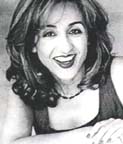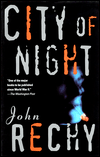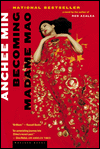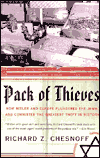| Gina Nahai | |
| Interview by Gavin J. Grant |
 Gina B. Nahai was born in Iran and educated in Switzerland and the United States. Since the publication of her first novel, the award-winning Cry of the Peacock, she has been hailed as one of the strongest new voices in fiction. Her complex and entertaining second novel, Moonlight on the Avenue of Faith, is a dark and realistic history of an Iranian family in the twentieth century.
Gina B. Nahai was born in Iran and educated in Switzerland and the United States. Since the publication of her first novel, the award-winning Cry of the Peacock, she has been hailed as one of the strongest new voices in fiction. Her complex and entertaining second novel, Moonlight on the Avenue of Faith, is a dark and realistic history of an Iranian family in the twentieth century.
She is a frequent lecturer on Iranian Jewish history and the topic of exile. During our conversation, she pointed out that there are now more Iranian Jews living in the Los Angeles area than there are in Iran. [An interesting book on the subject of Iranians living in the USA is Irangeles].
She has studied the politics of Iran for the U.S. Department of Defense, and currently teaches fiction writing at the University of Southern California's Master of Professional Writing program. Ms. Nahai lives with her family in Los Angeles.
Tell us a little about yourself.
I teach in the Masters Writing Program at USC. Before that I worked at various jobs, the Rand Corporation, and I also taught at UCLA for three years. Now what I do most is write.
I have a Masters from UCLA in International Relations and a Masters in Writing from USC. So now I am teaching beside some of my teachers.
How is that?
 It's sweet! And now some of my students are older than I am. At some point you just begin to take yourself a little less seriously.
It's sweet! And now some of my students are older than I am. At some point you just begin to take yourself a little less seriously.
I do feel I can contribute a lot to this particular program. A lot of writing programs are cocoons. People in them have this perception of themselves as writers but don't know what it entails. I've started added marketing and business information to my classes. I spend half the time talking about that stuff. The students have no idea what life would be like as writers. If they're not careful they'll all end up working at Enterprise Rent-a-Car! I give them names and places where they can get paid to do what they love. For instance, not many people know that community colleges pay three times as much as four-year colleges.
Some of my students have been writing their novels for seven years! I'll say I want an outline -- three pages, the beginning, the middle, and the end. And they can't do it -- they don't know how the novel ends. I tell them they have to conceive of an end. And the end will change anyway. Everything always changes as you write.
When did you last go to Iran?
I haven't been to Iran for 23 years.
What is it like to write about the country, not having been there for so long?
I keep the place alive in my mind. I try to be as historical and accurate as possible. Some readers told me there was a stark difference in the writing in my last book [Moonlight on the Avenue of Faith] between the sections set in Los Angeles and those set in Iran. The Los Angeles sections were harsh and devoid of the magic -- but it's much easier to see the dark parts when they're up close. My next novel [Sunday's Silence, due out this fall] is set in Appalachia. It's not the same as my first two novels, it doesn't deal with the same subjects: faith, and the differences and similarities between us. It's more about how weird and different America is.
What do you think is the relationship between Iranian-Americans and Iranians?
It's a pretty close relationship. Of course I'm talking about the Iranians who are conscious of those outside, not those who live far outside the cities in the villages. To those who are conscious there's always been such an incredible relationship between America and Iran. To many it's still The Great White Hope. The "Great Satan" and name-calling and all that was the work of such a small proportion of the people. America is still known as the Land of Good and Plenty. There's a 24-hour AM radio station here in America and you can tell there are people coming here constantly from Iran. There is such little distance and difference between the countries, especially in the minds of the young. The two countries are in almost constant communication, especially with the Internet. Do you know what the best-selling book in Iran over the past few years is? Men are From Mars, Women are From Venus! American films appear almost simultaneously in Iran, they go on video. Independence Day was a huge hit.
Does the Western media depiction of Iran ring true to you?
You've got to remember, at any one time the media can only depict one part of anything. Whatever it's showing is only one side of the story. There's a CNN reporter, Christiane Amanpour, the highest paid reporter in the world, who did a series of reports on going back to Iran after 30 years away. She showed the other side from what is usually shown -- those who love America, the middle class. It's true, though, that there's a great resistance in the media to showing anything from the Middle East.
When did you begin writing?
At first I didn't know you could write for publication. I didn't know any writers. The ones I knew were very depressed. Historically, a lot of Persian poets committed suicide! Then there was Margaret Duras who used to drink herself to sleep, wake up to write, then drink herself to sleep again. Arianna Fallaci had a hard life.
I used to write in Farsi when I lived in Iran. When I first came to America I wrote in French because my French was better than my English. But I've always liked reading in English. There is a freshness to literature in English. In French there are all these historical and grammatical rules. I also speak Spanish, so having read all these books before in all these languages makes the prose available to me a little richer. I can translate concepts from other languages that don't exist in English.
In your novels there are many stories within stories. Are they real stories?
 Almost all the stories are real. When I was writing Cry of the Peacock I went back to a lot of those people or people who had known them and asked them to tell me the stories. Other people volunteered stories -- that's where I got the story of Mercedes the Movie Star (from Moonlight on the Avenue of Faith). I couldn't tell all the stories I was told! Some people's lives are more eventful and I couldn't put them in the book. Then there are other people who swear they know the real-life counterpart of a character in the book and they're totally wrong. But a lot of the stories are real. There's a story in Cry of the Peacock about a man who puts out the eyes of all the people in one village and you can still go and see his house. It's still there.
Almost all the stories are real. When I was writing Cry of the Peacock I went back to a lot of those people or people who had known them and asked them to tell me the stories. Other people volunteered stories -- that's where I got the story of Mercedes the Movie Star (from Moonlight on the Avenue of Faith). I couldn't tell all the stories I was told! Some people's lives are more eventful and I couldn't put them in the book. Then there are other people who swear they know the real-life counterpart of a character in the book and they're totally wrong. But a lot of the stories are real. There's a story in Cry of the Peacock about a man who puts out the eyes of all the people in one village and you can still go and see his house. It's still there.
The characters' names in your novels are wonderful. Where did they come from?
Some of them are real names. Up until about the 1920s in Iran, people were traditionally known by a title, whatever was their main characteristic. So in Iran the character named Miriam the Moon would be read as, "Miriam who is as beautiful as the Moon." The Iranian word for moon is "Malh," which is very close to the word for "fish." So when I was young I used to wonder what kind of name is "Fish?" Why did they name her "Fish?" It wasn't until later that I understood.
What books or writers do you recommend?
I studied with John Rechy, who wrote City of Night. I'm always thanking and acknowledging him. Recently I read Anchee Min's Becoming Madame Mao. Also, I reviewed Richard Z. Chesnoff's Pack of Thieves. He works for U.S. News and World Report and he was one of the people who broke the story of the Swiss banks and the Holocaust survivors. He traveled all over Europe and he went to all these hiding places in the mountains. It's amazing, really amazing. It really makes your hair stand up.
Are there any bookshops you love?
Dutton's in Brentwood -- they're wonderful and every writer's friend.



